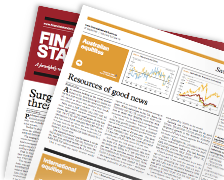Supporting members with their retirement decisionsBY ASHTON JONES | FRIDAY, 19 APR 2024 2:47PMChoosing how to structure a retirement nest egg is a highly personal decision for any superannuation member, and it can also be a complex one. By providing members with the right guidance at the right times, superannuation funds can help remove some of this complexity and drive better retirement outcomes - while still giving members the flexibility to choose which retirement pathway is right for them. The superannuation industry is in a period of profound change, with an increasing push for superannuation funds to improve retirement outcomes for their members. Designing better retirement income products is one thing, but trustees also need to provide the means for members to transition to the product that suits their needs. Personalised financial advice will always be a trusted option for helping members make decisions around their superannuation. We also anticipate that the outcomes of the Quality of Advice Review will make it easier for both advisers and funds to deliver guidance and advice to more members. But not every member will opt for advice, either because it's financially out of reach or because they're disengaged or unaware of their options. As an example, the TAL & Investment Trends 2023 Retirement Income Report found that 65% of pre-retirees aren't sure whether their fund offers pension products. The research also found that at the point of retirement, 22% of retired members kept their money in the accumulation phase, even though it may not best serve their interests in the long run. This suggests that building trustee-guided settings into retirement income products could have a positive impact on the lives of many retirees. So how could these settings work in practice? Guided settings are nothing new As consumers, we encounter guided settings every day: from Netflix content recommendations to automatic substitutes for out-of-stock items when buying groceries online. Some settings are specifically designed to protect consumers, like streaming or global roaming services that automatically switch to wi-fi only to prevent hefty data bills. There's also a range of trustee-guided settings within the superannuation system itself, like MySuper Lifestage investment strategies and standard levels of group insurance. For retirement specifically, members automatically stay in accumulation unless they actively choose to withdraw their superannuation or move to the pension phase. And once they're drawing a pension, the minimum SIS drawdown level becomes their standard setting. When we consider ways to include similar mechanisms into retirement income products, there are two potential approaches that trustees can begin thinking about, now and in the future. 1. Offering members a simpler choice For superannuation funds currently exploring design options for their retirement income products, one approach could be to incorporate guided settings based on the member's decision-making preferences. Essentially, this would involve asking the member before the point of retirement if they'd prefer to make their own decision about their retirement transition, or if they're happy for the trustee to guide them to a retirement product that will serve their best interests based on the information the trustee has about the member. For members who prefer the trustee to guide them, the fund could then provide a range of pre-determined settings matched to different member cohorts - similar to life-stage settings in accumulation products. This would make it easier for members to transition to a retirement product suitable to them. Importantly, this approach doesn't mean the member surrenders the right to change their mind. One of the misconceptions around taking up a retirement product is that the decision is irreversible; and while this may be the case for some traditional annuities, new pension and lifetime income solutions are being designed flexibly to offer a range of exit pathways, from spouse or death benefits to the simple option of withdrawing from the product at any time. 2. Further support for members who need it Another potential approach is to provide more active support to members who remain in the accumulation phase simply because they haven't made a decision about retirement products. This would enable trustees to transition these members more easily into a retirement product better suited to their specific needs or financial situation. Under the current rules, however, a PDS needs to be issued and the member's consent provided before they can switch product types. This approach would therefore require legislative change to allow a trustee-guided transition from an accumulation product to a retirement income product. The trustee would also need to obtain the member's account details to make retirement income payments to the member's nominated account, which would provide an opportunity to engage with the member before the point of retirement. MySuper products already exist for accumulation, so it makes sense that we provide a path to improve outcomes for MySuper members who don't exercise a decision about their preferred product in retirement. In this instance, trustees would have a fiduciary responsibility to manage the member's retirement savings consistent with the member's best financial interests across both the superannuation and retirement phases of their journey with the fund. Helping more members retire with confidence For many Australians, deciding how to use their retirement savings is one of the most important decisions they'll ever make. But the reality is that there will always be members who don't exercise their right to choose how to use their superannuation. This may be due to disengagement, a lack of financial literacy, cognitive decline or even the inherent complexities in the options available. Many trustees are already on the journey to expand their retirement offering, with an emerging focus on lifetime income products that manage longevity risk and provide the confidence to spend. But what's even more important is to reduce the transition-to-retirement complexity for members who aren't in a position to make the best decision for their own retirement needs. By making the decision as simple as possible - and giving members the option to put more of the decision in the trustee's hands if they prefer - superannuation funds will be able to deliver better outcomes for more retirees while ensuring that no member gets left behind. |
Latest News
Aware Super delivers double digit returns
|HESTA returns 10.18% to members
|CareSuper to undertake cloud transformation
|BUSSQ's boardroom brass cleared, CFMEU spend deemed sound
Cover Story

Climbing to the top
MANAGING DIRECTOR
VANGUARD INVESTMENTS AUSTRALIA LTD
























It is also up to government to be braver with simplification. Responding to the Quality of Advice Review has taken much too long. I made a list of over 20 items that should go from tax and welfare. Starting with the RAD, the asset test, the transfer balance cap (lower and index the $3m), the bring forward rules, the application of CH 7 of the Corps Act to Super fund trustees (Best financial interests duty covers it) ... See my submission (no 24) at https://www.aph.gov.au/Parliam...